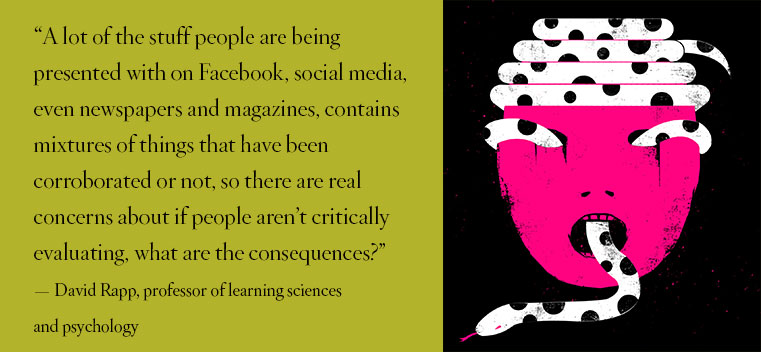
Mind the Misinformation
Written by junior Anna Waters, with reporting by senior editor Sean Hargadon.
Tell us what you think. E-mail comments or questions to the editors at letters@northwestern.edu.
Find Us on Social Media
Psychology prof David Rapp explains why we fall victim to fake news.
The shocking conclusion to the 2016 presidential election sparked debate over the concept of “fake news,” or articles from hoax sites or conspiracy theorists that lack any basis in fact. The impact of stories like “Five Million Uncounted Sanders Ballots Found on Clinton’s Email Server” or “Pope Francis Shocks World, Endorses Donald Trump for President” on the actual outcome of the election is difficult to discern, but their impact on social media is clear. A BuzzFeed analysis of the most-shared false election stories compared to the most-shared true election stories showed that fake outperformed real. Another survey found that fake news headlines fool American adults 75 percent of the time.
Independent of partisanship, the idea that American political discourse centers more on falsehood than fact is concerning. In the age of the internet, information is supposed to be democratized — any adult can search independent fact-checking sites like PolitiFact or Snopes to see that the Sanders ballots and Pope endorsement stories have no basis in truth. But for some reason, a majority of us are still fooled. Why?
In short, according to Northwestern psychology professor David Rapp, it’s how we’re wired. His research on memory and learning has shown that our minds quickly memorize information we learn, independent of its validity or source. If we later discover that it is false, that does not necessarily override the initial story.
“A lot of our research looks at what happens when people encounter information that’s not true, and when they know it’s not true,” Rapp says. “We’ve shown that people will repeat that information and use it. We don’t know if they believe it, but we know they’re going to repeat it and we know they’re going to use it. That’s a real problem.
“We’re interested in finding out what happens when you correct that inaccurate information, how likely are people to encode, learn the correction and overwrite the false information that they read before,” Rapp says. “What we’re seeing in our work is that people aren’t really good at it because everything sort of gets mixed up in memory. We’re not really good at tagging.”
So if our minds naturally recall information even if we know it to be false, how can we stay informed?
One way, Rapp suggests, is to proactively think critically. Making the effort to fact-check information may not be foolproof, but it does help. Compartmentalizing questionable information into a “not true” mental category can help organize memory and separate fact from fiction.
Speaking of fiction, Rapp’s research has shown that our minds do have the ability to think critically about stories that are part-true, part-false — but it’s much easier when the reader is primed to know the details may not all be accurate.
For example, Rapp says that while reading Harry Potter, which includes facts about actual street names and places in London but falsehoods about witches and wizards, people are more careful about separating truth from fiction. The lesson for fake news?
“If there’s something about the experience that makes you think it might not be relevant for the real world, you’re a little better at not falling victim to inaccurate information,” Rapp says.
But that skill is impossible without having critical thinking skills in the first place.
“Providing people with an understanding of what counts as good evidence, the kind of thing you learn in journalism school or studying science, is the same practice we hope people utilize in the real world, but not everyone has had experience doing that,” Rapp says. “There are some sources online that give advice for what constitutes a good website. That’s really useful, because people don’t know.”
Rapp also recommends self-awareness about the fallibility of memory. He gives the example of a memory effect where, if information can be retrieved quickly, it’s more likely to feel true. That effect is often a helpful way to sort truth from fiction — if you’ve heard information repeatedly from multiple sources, it might be more likely to be correct. But that can be dangerous, especially on social media, where falsehoods spread like wildfire.
“A lot of the stuff people are being presented with on Facebook, social media, even newspapers and magazines, contains mixtures of things that have been corroborated or not,” Rapp says, “so there are real concerns about if people aren’t critically evaluating, what are the consequences?”
And when we’re interacting with someone duped by fake news, Rapp recommends engaging. “When someone says something, ask, ‘Hey, where’d you get that from? What’s the evidence?’ and really talk about it.”



 Facebook
Facebook Twitter
Twitter Email
Email


